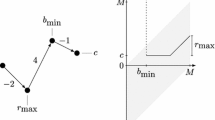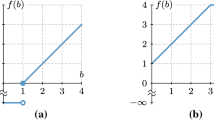Abstract
High hopes are put in electric vehicles to lower global green house gas emissions. From an operational perspective, however, their limited range and the long recharging times add considerable complexity to the decision tasks planning their efficient application. In this context, we treat a problem setting where a single electric vehicle executes transport requests along a straight line, which, for instance, occurs when cranes, automated guided vehicles, or shuttles handle boxes in container terminals. From time to time the vehicle needs to be recharged and, thus, has to visit some charging station also located on the line. We investigate the scheduling of a single electric vehicle, so that the makespan for executing all transport requests is minimized and the vehicle is timely recharged. The solution algorithm developed is then applied to also explore the location planning of charging stations.




Similar content being viewed by others
References
Alesiani, F., & Maslekar, N. (2014). Optimization of charging stops for fleet of electric vehicles: A genetic approach. IEEE Intelligent Transportation Systems Magazine, 6, 10–21.
Atallah, M. J., & Kosaraju, S. R. (1988). Efficient solutions to some transportation problems with applications to minimizing robot arm travel. SIAM Journal on Computing, 17, 849–869.
Bae, S. H., Sarkis, V., & Yoo, C. S. (2011). Greening transportation fleets: Insights from a two-stage game theoretic model. Transportation Research Part E: Logistics and Transportation Review, 47, 793–807.
Bierwirth, C., & Meisel, F. (2010). A survey of berth allocation and quay crane scheduling problems in container terminals. European Journal of Operational Research, 202, 615–627.
Boysen, N., & Stephan, K. (2016). A survey on single crane scheduling in automated storage/retrieval systems. European Journal of Operational Research, 254, 691–704.
Boysen, N., Fliedner, M., Jaehn, F., & Pesch, E. (2013). A survey on container processing in railway yards. Transportation Science, 47, 312–329.
Boysen, N., Briskorn, D., & Meisel, F. (2017). Crane scheduling with non-crossing constraints: Classification and literature review. European Journal of Operational Research, 258, 343–257.
Brandenburg, M., Govindan, K., Sarkis, J., & Seuring, S. (2014). Quantitative models for sustainable supply chain management: Developments and directions. European Journal of Operational Research, 233, 299–312.
Bruns, F., & Knust, S. (2012). Optimized load planning of trains in intermodal transportation. OR Spectrum, 34, 511–533.
Burkard, R. E., Deineko, V. G., van Dal, R., van der Veen, J. A., & Woeginger, G. J. (1998). Well-solvable special cases of the traveling salesman problem: A survey. SIAM Review, 40, 496–546.
Dekker, R., Bloemhof, J., & Mallidis, I. (2012). Operations research for green logistics—An overview of aspects, issues, contributions and challenges. European Journal of Operational Research, 219, 671–679.
Delucchi, M. A., & Lipman, T. E. (2001). An analysis of the retail and lifecycle cost of battery-powered electric vehicles. Transportation Research Part D: Transport and Environment, 6, 371–404.
Demir, E., Bektas, T., & Laporte, G. (2014). A review of recent research on green road freight transportation. European Journal of Operational Research, 237, 775–793.
Erdogan, S., & Miller-Hooks, E. (2012). A green vehicle routing problem. Transportation Research Part E: Logistics and Transportation Review, 48, 100–114.
Feng, W., & Figliozzi, M. (2013). An economic and technological analysis of the key factors affecting the competitiveness of electric commercial vehicles: A case study from the USA market. Transportation Research Part C: Emerging Technologies, 26, 135–145.
Garey, M. R., & Johnson, D. S. (1979). Computers and intractability: A guide to the theory of NP-completeness. New York: Freeman.
Gilmore, P. C., & Gomory, R. E. (1964). Sequencing a one state-variable machine: A solvable case of the traveling salesman problem. Operations Research, 12, 655–679.
Goldberg, D. E. (1989). Genetic alghorithms in search, optimization & machine learning. Reading, MA: Addison-Wesley Publishing Company Inc.
Goldberg, D.E., & Deb, K. (1991). A comparison of selection schemes used in genetic algorithms. In G. J. E. Rawlins (Ed.), Foundations of Genetic Algorithms (pp. 69–93). San Mateo: Morgan Kaufmann.
Grigoriev, A., & van de Klundert, J. (2006). On the high multiplicity traveling salesman problem. Discrete Optimization, 3, 50–62.
Guan, D. J. (1998). Routing a vehicle of capacity greater than one. Discrete Applied Mathematics, 81, 41–57.
Haupt, R. L., & Haupt, S. E. (2004). The continuous genetic algorithm. Practical genetic algorithms (2nd ed.). Hoboken, NJ: Wiley.
Holland, J. H. (1975). Adaptation in natural and artificial systems: An introductory analysis with applications to biology, control, and artificial intelligence. Ann Arbor, MI: University of Michigan Press.
Jaehn, F. (2016). Sustainable Operations. European Journal of Operational Research, 253, 243–264.
Lin, C., Choy, K. L., Ho, G. T. S., Chung, S. H., & Lam, H. Y. (2014). Survey of green vehicle routing problem: Past and future trends. Expert Systems with Applications, 41, 1118–1138.
Miller, C. E., Tucker, A. W., & Zemlin, R. A. (1960). Integer programming formulation of traveling salesman problems. Journal of the ACM (JACM), 7, 326–329.
Passchyn, W., Briskorn, D., & Spieksma, F. C. (2016). Mathematical programming models for lock scheduling with an emission objective. European Journal of Operational Research, 248, 802–814.
Pelletier, S., Jabali, O., & Laporte, G. (2016). Goods distribution with electric vehicles: Review and research perspectives. Transportation Science, 50, 3–22.
Psaraftis, H., Solomon, M., Magnanti, T., & Kim, T.-U. (1990). Routing and scheduling on a shoreline with release times. Management Science, 36, 212–223.
Reeves, C. R. (1997). Genetic algorithms for the operations researcher. INFORMS Journal on Computing, 9, 231–250.
Roodbergen, K. J., & Vis, I. F. (2009). A survey of literature on automated storage and retrieval systems. European Journal of Operational Research, 194, 343–362.
Rotter, H. (2004). New operating concepts for intermodal transport: The mega hub in Hanover/Lehrte in Germany. Transportation Planning and Technology, 27, 347–365.
Schneider, M., Stenger, A., & Goeke, D. (2014). The electric vehicle-routing problem with time windows and recharging stations. Transportation Science, 48, 500–520.
Simchi-Levi, D., & Berman, O. (1992). Minimizing the total flow time of n jobs on a network. IIE Transactions, 23, 236–244.
Srivastava, S. K. (2007). Green supply chain management: A state of the art literature review. International Journal of Management Reviews, 9, 53–80.
Sweda, T.M., Dolinskaya, I.S., & Klabjan, D. (2014). Optimal recharging policies for electric vehicles. Working paper no.14-01, Department of Industrial Engineering and Management Sciences, Northwestern University.
Tsitsiklis, J. N. (1992). Special cases of traveling salesman and repairman problems with time windows. Networks, 22, 263–282.
Vis, I. F. (2006). Survey of research in the design and control of automated guided vehicle systems. European Journal of Operational Research, 170, 677–709.
Wang, Y. W. (2007). An optimal location choice model for recreation-oriented scooter recharge stations. Transportation Research Part D: Transport and Environment, 12, 231–237.
Wang, Y. W., & Lin, C. C. (2013). Locating multiple types of recharging stations for battery-powered electric vehicle transport. Transportation Research Part E: Logistics and Transportation Review, 58, 76–87.
Yang, J., & Sun, H. (2015). Battery swap station location-routing problem with capacitated electric vehicles. Computers & Operations Research, 55, 217–232.
Yilmaz, M., & Krein, P. T. (2013). Review of battery charger topologies, charging power levels, and infrastructure for plug-in electric and hybrid vehicles. IEEE Transactions on Power Electronics, 28, 2151–2169.
Yu, W., & Liu, Z. (2009). Vehicle routing problems on a line-shaped network with release time constraints. Operations Research Letters, 37, 85–88.
Author information
Authors and Affiliations
Corresponding author
Rights and permissions
About this article
Cite this article
Boysen, N., Briskorn, D. & Emde, S. Scheduling electric vehicles and locating charging stations on a path. J Sched 21, 111–126 (2018). https://doi.org/10.1007/s10951-017-0538-9
Published:
Issue Date:
DOI: https://doi.org/10.1007/s10951-017-0538-9




